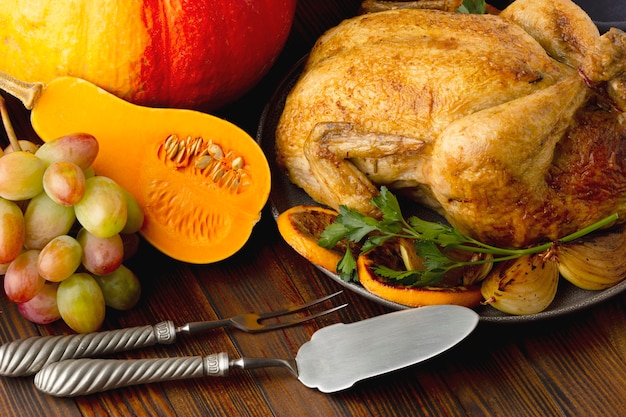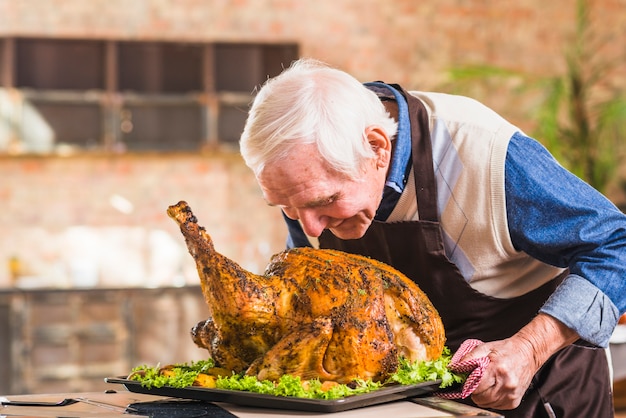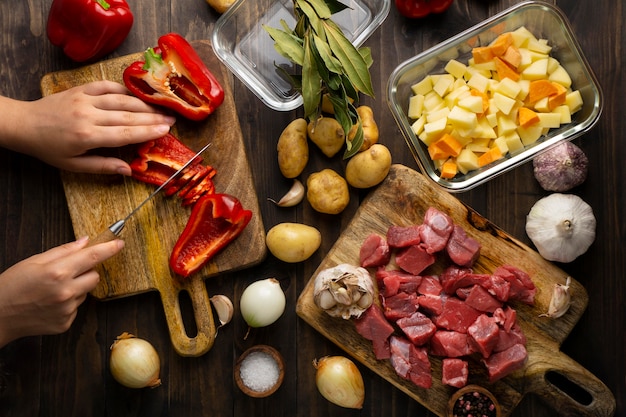Let's be honest, the idea of roasting a turkey can feel a bit intimidating, especially for someone new to the kitchen. I remember my first attempt – I was so excited to get started, but the end result was far from the picture-perfect golden bird I'd envisioned. It was dry, tough, and frankly, a bit of a disaster. But don't worry, that's why I'm here!
Over the years, I've learned a few things about turkey cooking, and I'm ready to share them with you. This guide is all about breaking down the process into manageable steps, so even the most novice cook can confidently prepare a delicious Thanksgiving or Christmas turkey. We'll cover everything from picking the perfect bird to making the most incredible gravy, and even tackle the often-dreaded carving process. So, grab your favorite apron, put on some festive tunes, and let's get started!
(Part 1) Selecting Your Bird: The Foundation of a perfect roast

Choosing the Right Turkey: Fresh or Frozen?
The first big decision is whether to go for a fresh or frozen turkey. Fresh turkeys are fantastic, especially if you have a reliable butcher nearby. They tend to have a more intense flavour and are often juicier.
But, let's face it, life gets busy, and sometimes frozen is the way to go. If you choose frozen, just make sure you defrost it properly – we'll discuss that later on.
Size Matters: Deciding on the Right Size Turkey
Once you've decided fresh or frozen, it's time to think about size. You want enough turkey for everyone to enjoy without leftovers going to waste (though, a few leftovers for delicious sandwiches and turkey soup are always welcome!). A general rule of thumb is to allow about 1 pound of turkey per person. That said, you can always adjust this based on your guests' appetites and how much you expect to eat as leftovers.
Turkey Check-up: Looking for the Perfect Bird
With the size sorted, give your turkey a good look-over. The skin should be smooth, firm, and a healthy color. Avoid any turkeys that have discolored patches or feel slimy – that's a sign it might not be fresh. Ideally, the breasts should be plump, and the legs should be firm.
(Part 2) Prepping Your Turkey: Getting Ready to Roast

Removing the Giblets: A Quick and Essential Task
Alright, your turkey is home, and now it's time to get prepped. The first thing to do is remove the giblets – the neck, heart, and liver – which are usually packaged in a small bag inside the cavity. Don't worry, these are great for making a rich and flavorful stock later.
Patting Dry: A Crucial Step for crispy skin
Now, give your turkey a good pat dry with kitchen paper. This is a crucial step for achieving that beautiful, crispy skin. Wet skin can lead to a soggy turkey, and nobody wants that!
Brining: The Secret to Extra Moisture
Brining is a popular technique that many cooks swear by. It involves soaking your turkey in a saltwater solution for several hours, which helps to lock in moisture and creates a tender, juicy bird. However, it's not essential, and some find it unnecessary.
If you decide to go for it, you'll need a large container – a big stockpot or a cooler works well. Brine for at least 8 hours, and up to 24 hours for best results.
(Part 3) Choosing the Stuffing: A Matter of Taste

Traditional or Savoury? The Stuffing Debate
Stuffing is a classic Thanksgiving and Christmas tradition, but it's not without its debates. Some people prefer the traditional stuffing, packed with breadcrumbs, herbs, and dried fruit, while others prefer a savory stuffing with sausage, onions, and herbs. It's completely up to you!
Stuffing Safety: Cook It Separately
Whatever your stuffing preference, it's essential to cook it separately from the turkey. This is a critical food safety rule. The stuffing needs to reach a safe internal temperature of 165°F (74°C), and cooking it inside the turkey doesn't always guarantee that.
Stuffing Options: Bread-Based, Sausage-Based, or Even Wild Card!
The possibilities for stuffing are endless! You can stick with the classics, or get creative and experiment with different flavours and ingredients. Here are a few ideas to get you started:
- Bread-Based Stuffing: This is the classic option, using a base of bread, onions, celery, and herbs. You can add dried fruit for sweetness or sausage for extra flavour.
- Sausage Stuffing: This stuffing features sausage, onions, and herbs. It's a delicious, savory option that complements the turkey beautifully.
- Wild Card Stuffing: Don't be afraid to get creative! You could try a wild rice stuffing, a cornbread stuffing, or even a stuffing with a Mediterranean twist.
(Part 4) Roasting Your Turkey: The Grand Finale
Getting Ready: Oven Temperature and roasting time
Your turkey is prepped, the stuffing is ready, and it's time to roast! Preheat your oven to 325°F (160°C). The roasting time will depend on the size of your turkey. A good rule of thumb is about 15 minutes per pound for an unstuffed turkey. If you're stuffing the bird, add an extra 30 minutes to the roasting time.
The Butter Basting Technique: For a Golden Crust
Now, for that beautiful golden-brown crust, give your turkey a good basting with melted butter. You can do this every 30 minutes or so. Don't forget to baste the legs and thighs too, for extra flavour.
The turkey thermometer: Your Essential Tool
To ensure your turkey is cooked through, invest in a meat thermometer. It's the only way to be sure! The internal temperature should reach at least 165°F (74°C) in the thickest part of the thigh.
Resting Time: Let the Turkey Relax
Once your turkey is cooked, let it rest for about 20 minutes before carving. This allows the juices to redistribute, making it more succulent and flavorful.
(Part 5) Making the Gravy: The Perfect Complement
Gravy from Pan Drippings: The Classic Method
The gravy is the star of the show, adding a rich, savory element to your turkey feast. The classic method involves making it from the pan drippings. Here's how:
1. Carefully pour the drippings from your roasting pan into a saucepan.
2. Add a tablespoon or two of flour, whisking constantly to create a smooth mixture.
3. Gradually add chicken or turkey stock, whisking constantly to avoid lumps.
4. Continue whisking until the gravy thickens to your desired consistency.
Adjusting the Flavor: Salt, Pepper, and Herbs
Once your gravy is thickening, season it with salt, pepper, and herbs to your liking. A pinch of dried thyme or rosemary adds a lovely flavour.
Alternative Gravy Options: For a More Modern Twist
If you're not keen on making gravy from pan drippings, don't fret! There are plenty of other options:
- Store-bought Gravy Mix: This is a quick and easy option if you're short on time. Just follow the instructions on the package.
- homemade gravy from Scratch: For a more flavorful and customizable gravy, you can make your own from scratch. There are countless recipes online, so find one that appeals to your taste.
(Part 6) Carving the Turkey: A Skill Worth Mastering
Getting Started: Gather Your Tools and Prepare the Turkey
Carving the turkey can feel a bit intimidating, but with a little practice, you'll be a pro in no time. Start by gathering your tools – a sharp carving knife and a carving fork are essential. Place your turkey on a carving board, and you're ready to go.
Removing the Legs and Thighs: A Gentle Approach
Begin by removing the legs and thighs. Use the tip of your carving knife to cut through the skin at the joint between the leg and thigh. Then, carefully cut along the bone, separating the leg and thigh from the turkey.
Removing the Breasts: Working Carefully
Now, it's time to remove the breasts. Use your carving knife to slice through the skin and then carefully cut along the bone, separating the breast from the bone.
Presenting the Turkey: A Festive Feast
Once your turkey is carved, arrange it beautifully on a platter, surrounded by your favorite sides. Then, prepare to enjoy the fruits of your labor!
(Part 7) Serving and Storing Leftovers: Making the Most of Your Turkey
Serving Up the Turkey: A Feast for the Senses
Now, your turkey is cooked, carved, and ready to serve. Arrange the pieces on a platter and serve it with your favourite sides. Don't forget the gravy!
Storing Leftovers: Keeping Your Turkey Safe
Leftover turkey is a delicious treat, but it's important to store it properly. Let the turkey cool down completely before putting it in the fridge. Keep it in an airtight container and use it within 3-4 days.
Getting Creative with Leftovers: turkey recipes Beyond the Roast
Don't let your leftover turkey go to waste! There are countless delicious ways to use it up. Here are a few ideas to get you started:
- turkey sandwiches: A classic! Make a simple turkey sandwich with mayonnaise, lettuce, and tomato, or get creative with different bread types and fillings.
- Turkey Soup: Combine leftover turkey with vegetables, broth, and noodles for a hearty and comforting soup.
- turkey salad: Combine chopped leftover turkey with mayonnaise, celery, onion, and herbs for a delicious salad.
- turkey pot pie: Use leftover turkey to make a filling and flavorful pot pie.
- Turkey Curry: Give your leftovers a global twist with a delicious and aromatic turkey curry.
(Part 8) FAQs: Answers to Your Turkey Cooking Questions
Q: How do I defrost a frozen turkey safely?
A: Defrost your turkey in the refrigerator, allowing about 24 hours for every 5 pounds of turkey. This is the safest way to defrost, as it prevents bacteria from multiplying. You can also defrost it in cold water, but make sure the water is constantly running and changing.
Q: Can I stuff the turkey with raw vegetables?
A: It's best to avoid stuffing the turkey with raw vegetables. The vegetables won't cook thoroughly, and this can pose a food safety risk. Instead, add vegetables to your stuffing mixture after it's been cooked, or use them as a separate side dish.
Q: What should I do if the turkey skin is burning but the inside is not cooked?
A: If the turkey skin is burning but the inside isn't cooked, tent the turkey with foil to prevent further burning. Make sure you check the temperature with a meat thermometer to ensure it's cooked through.
Q: What's the best way to cook a turkey breast?
A: Turkey breast is best cooked separately from the whole bird. You can roast it in the oven, grill it, or even cook it in a skillet. Just make sure it reaches an internal temperature of 165°F (74°C).
Q: Can I freeze cooked turkey?
A: Yes, you can freeze cooked turkey. Wrap it tightly in plastic wrap or aluminum foil and then place it in a freezer bag. It should last for up to 2 months in the freezer.
And there you have it – a beginner's guide to perfect turkey cooking, from choosing the bird to making the gravy. I hope this has given you the confidence to tackle your next turkey roast. Happy cooking!
Everyone is watching

Perfect Rice Every Time: The Ultimate Guide to Cooking Rice
Cooking TipsAs a self-proclaimed foodie, I've always been a bit obsessed with rice. It's the foundation of countless cuisi...

Ultimate Guide to Cooking the Perfect Thanksgiving Turkey
Cooking TipsThanksgiving. Just the word conjures up images of overflowing tables laden with delicious food, the scent of r...

The Ultimate Guide to Cooking Asparagus: Tips, Techniques, and Recipes
Cooking TipsAsparagus. The mere mention of this spring delicacy conjures up images of vibrant green spears, crisp and burs...

Can You Cook Spaghetti with Gasoline? (The Shocking Truth)
Cooking TipsWe've all seen those crazy internet trends. You know, the ones that make you wonder, "Did someone actually try...

Chorizo and Eggs Recipe: The Ultimate Guide
Cooking TipsRight, let’s talk about chorizo and eggs. You know, that classic Spanish dish that's always a winner. It's th...
